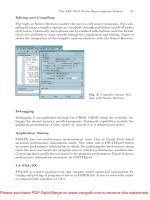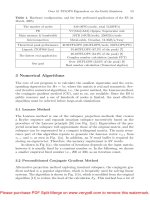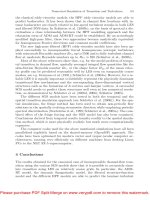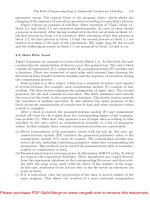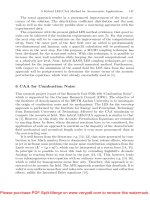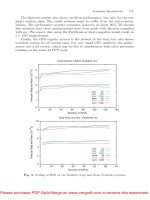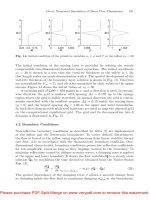High performance computing for big data methodologies and applications (chapman hall CRC big data series)
Bạn đang xem bản rút gọn của tài liệu. Xem và tải ngay bản đầy đủ của tài liệu tại đây (7.95 MB, 361 trang )
Chapman & Hall/CRC
Big Data Series
SERIES EDITOR
Sanjay Ranka
AIMS AND SCOPE
This series aims to present new research and applications in Big
Data, along with the computational tools and techniques currently
in development. The inclusion of concrete examples and
applications is highly encouraged. The scope of the series includes,
but is not limited to, titles in the areas of social networks, sensor
networks, data-centric computing, astronomy, genomics, medical
data analytics, large-scale e-commerce, and other relevant topics
that may be proposed by potential contributors.
PUBLISHED TITLES
HIGH PERFORMANCE COMPUTING FOR BIG DATA
Chao Wang
FRONTIERS IN DATA SCIENCE
Matthias Dehmer and Frank Emmert-Streib
BIG DATA MANAGEMENT AND PROCESSING
Kuan-Ching Li, Hai Jiang, and Albert Y. Zomaya
BIG DATA COMPUTING: A GUIDE FOR BUSINESS AND
TECHNOLOGY MANAGERS
Vivek Kale
BIG DATA IN COMPLEX AND SOCIAL NETWORKS
My T. Thai, Weili Wu, and Hui Xiong
BIG DATA OF COMPLEX NETWORKS
Matthias Dehmer, Frank Emmert-Streib, Stefan Pickl, and Andreas
Holzinger
BIG DATA : ALGORITHMS, ANALYTICS, AND
APPLICATIONS
Kuan-Ching Li, Hai Jiang, Laurence T. Yang, and Alfredo
Cuzzocrea
CRC Press
Taylor & Francis Group
6000 Broken Sound Parkway NW, Suite 300
Boca Raton, FL 33487-2742
© 2018 by Taylor & Francis Group, LLC
CRC Press is an imprint of Taylor & Francis Group, an Informa business
No claim to original U.S. Government works
Printed on acid-free paper
International Standard Book Number-13: 978-1-4987-8399-6 (Hardback)
This book contains information obtained from authentic and highly regarded sources. Reasonable
efforts have been made to publish reliable data and information, but the author and publisher cannot
assume responsibility for the validity of all materials or the consequences of their use. The authors and
publishers have attempted to trace the copyright holders of all material reproduced in this publication
and apologize to copyright holders if permission to publish in this form has not been obtained. If any
copyright material has not been acknowledged please write and let us know so we may rectify in any
future reprint.
Except as permitted under U.S. Copyright Law, no part of this book may be reprinted, reproduced,
transmitted, or utilized in any form by any electronic, mechanical, or other means, now known or
hereafter invented, including photocopying, microfilming, and recording, or in any information storage
or retrieval system, without written permission from the publishers.
For permission to photocopy or use material electronically from this work, please access
www.copyright.com ( or contact the Copyright Clearance Center, Inc.
(CCC), 222 Rosewood Drive, Danvers, MA 01923, 978-750-8400. CCC is a not-for-profit organization
that provides licenses and registration for a variety of users. For organizations that have been granted a
photocopy license by the CCC, a separate system of payment has been arranged.
Trademark Notice: Product or corporate names may be trademarks or registered trademarks, and are
used only for identification and explanation without intent to infringe.
Visit the Taylor & Francis Web site at
and the CRC Press Web site at
Contents
Preface
Acknowledgments
Editor
Contributors
SECTION I Big Data Architectures
CHAPTER 1
◾
CHAPTER 2
◾
CHAPTER 3
◾
CHAPTER 4
◾
Dataflow Model for Cloud Computing Frameworks in Big Data
DONG DAI, YONG CHEN, AND GANGYONG JIA
Design of a Processor Core Customized for Stencil
Computation
YOUYANG ZHANG, YANHUA LI, AND YOUHUI ZHANG
Electromigration Alleviation Techniques for 3D Integrated
Circuits
YUANQING CHENG, AIDA TODRI-SANIAL, ALBERTO BOSIO, LUIGI
DILILLO, PATRICK GIRARD, ARNAUD VIRAZEL, PASCAL VIVET,
AND MARC BELLEVILLE
A 3D Hybrid Cache Design for CMP Architecture for DataIntensive Applications
ING-CHAO LIN, JENG-NIAN CHIOU, AND YUN-KAE LAW
SECTION II Emerging Big Data Applications
CHAPTER 5
◾
CHAPTER 6
◾
Matrix Factorization for Drug-Target Interaction Prediction
YONG LIU, MIN WU, XIAO-LI LI, AND PEILIN ZHAO
Overview of Neural Network Accelerators
YUNTAO LU, CHAO WANG, LEI GONG, XI LI, AILI WANG, AND
XUEHAI ZHOU
CHAPTER 7
◾
CHAPTER 8
◾
CHAPTER 9
◾
Acceleration for Recommendation Algorithms in Data Mining
CHONGCHONG XU, CHAO WANG, LEI GONG, XI LI, AILI WANG,
AND XUEHAI ZHOU
Deep Learning Accelerators
YANGYANG ZHAO, CHAO WANG, LEI GONG, XI LI, AILI WANG,
AND XUEHAI ZHOU
Recent Advances for Neural Networks Accelerators and
Optimizations
FAN SUN, CHAO WANG, LEI GONG, XI LI, AILI WANG, AND
XUEHAI ZHOU
CHAPTER 10
◾
CHAPTER 11
◾
CHAPTER 12
◾
INDEX
Accelerators for Clustering Applications in Machine Learning
YIWEI ZHANG, CHAO WANG, LEI GONG, XI LI, AILI WANG, AND
XUEHAI ZHOU
Accelerators for Classification Algorithms in Machine
Learning
SHIMING LEI, CHAO WANG, LEI GONG, XI LI, AILI WANG, AND
XUEHAI ZHOU
Accelerators for Big Data Genome Sequencing
HAIJIE FANG, CHAO WANG, SHIMING LEI, LEI GONG, XI LI, AILI
WANG, AND XUEHAI ZHOU
Preface
become more data intensive, the
management of data resources and dataflow between the storage and
computing resources is becoming a bottleneck. Analyzing, visualizing, and
managing these large data sets is posing significant challenges to the research
community. The conventional parallel architecture, systems, and software
will exceed the performance capacity with this expansive data scale. At
present, researchers are increasingly seeking a high level of parallelism at the
data level and task level using novel methodologies for emerging
applications. A significant amount of state-of-the-art research work on big
data has been executed in the past few years.
This book presents the contributions of leading experts in their respective
fields. It covers fundamental issues about Big Data, including emerging highperformance architectures for data-intensive applications, novel efficient
analytical strategies to boost data processing, and cutting-edge applications in
diverse fields, such as machine learning, life science, neural networks, and
neuromorphic engineering. The book is organized into two main sections:
A
S SCIENTIFIC APPLICATIONS HAVE
1. “Big Data Architectures” considers the research issues related to the
state-of-the-art architectures of big data, including cloud computing
systems and heterogeneous accelerators. It also covers emerging 3D
integrated circuit design principles for memory architectures and
devices.
2. “Emerging Big Data Applications” illustrates practical applications of
big data across several domains, including bioinformatics, deep
learning, and neuromorphic engineering.
Overall, the book reports on state-of-the-art studies and achievements in
methodologies and applications of high-performance computing for big data
applications.
The first part includes four interesting works on big data architectures. The
contribution of each of these chapters is introduced in the following.
In the first chapter, entitled “Dataflow Model for Cloud Computing
Frameworks in Big Data,” the authors present an overview survey of various
cloud computing frameworks. This chapter proposes a new “controllable
dataflow” model to uniformly describe and compare them. The fundamental
idea of utilizing a controllable dataflow model is that it can effectively isolate
the application logic from execution. In this way, different computing
frameworks can be considered as the same algorithm with different control
statements to support the various needs of applications. This simple model
can help developers better understand a broad range of computing models
including batch, incremental, streaming, etc., and is promising for being a
uniform programming model for future cloud computing frameworks.
In the second chapter, entitled “Design of a Processor Core Customized
for Stencil Computation,” the authors propose a systematic approach to
customizing a simple core with conventional architecture features, including
array padding, loop tiling, data prefetch, on-chip memory for temporary
storage, online adjusting of the cache strategy to reduce memory traffic,
Memory In-and-Out and Direct Memory Access for the overlap of
computation (instruction-level parallelism). For stencil computations, the
authors employed all customization strategies and evaluated each of them
from the aspects of core performance, energy consumption, chip area, and so
on, to construct a comprehensive assessment.
In the third chapter, entitled “Electromigration Alleviation Techniques for
3D Integrated Circuits,” the authors propose a novel method called TSVSAFE to mitigate electromigration (EM) effect of defective through-silicon
vias (TSVs). At first, they analyze various possible TSV defects and
demonstrate that they can aggravate EM dramatically. Based on the
observation that the EM effect can be alleviated significantly by balancing
the direction of current flow within TSV, the authors design an online selfhealing circuit to protect defective TSVs, which can be detected during the
test procedure, from EM without degrading performance. To make sure that
all defective TSVs are protected with low hardware overhead, the authors
also propose a switch network-based sharing structure such that the EM
protection modules can be shared among TSV groups in the neighborhood.
Experimental results show that the proposed method can achieve over 10
times improvement on mean time to failure compared to the design without
using such a method, with negligible hardware overhead and power
consumption.
In the fourth chapter, entitled “A 3D Hybrid Cache Design for CMP
Architecture for Data-Intensive Applications,” the authors propose a 3D
stacked hybrid cache architecture that contains three types of cache bank:
SRAM bank, STT-RAM bank, and STT-RAM/SRAM hybrid bank for chip
multiprocessor architecture to reduce power consumption and wire delay.
Based on the proposed 3D hybrid cache with hybrid local banks, the authors
propose an access-aware technique and a dynamic partitioning algorithm to
mitigate the average access latency and reduce energy consumption. The
experimental results show that the proposed 3D hybrid cache with hybrid
local banks can reduce energy by 60.4% and 18.9% compared to 3D pure
SRAM cache and 3D hybrid cache with SRAM local banks, respectively.
With the proposed dynamic partitioning algorithm and access-aware
technique, our proposed 3D hybrid cache reduces the miss rate by 7.7%,
access latency by 18.2%, and energy delay product by 18.9% on average.
The second part includes eight chapters on big data applications. The
contribution of each of these chapters is introduced in the following.
In the fifth chapter, entitled “Matrix Factorization for Drug–Target
Interaction Prediction,” the authors first review existing methods developed
for drug–target interaction prediction. Then, they introduce neighborhood
regularized logistic matrix factorization, which integrates logistic matrix
factorization with neighborhood regularization for accurate drug–target
interaction prediction.
In the sixth chapter, entitled “Overview of Neural Network Accelerators,”
the authors introduce the different accelerating methods of neural networks,
including ASICs, GPUs, FPGAs, and modern storage, as well as the opensource framework for neural networks. With the emerging applications of
artificial intelligence, computer vision, speech recognition, and machine
learning, neural networks have been the most useful solution. Due to the low
efficiency of neural networks implementation on general processors, variable
specific heterogeneous neural network accelerators were proposed.
In the seventh chapter, entitled “Acceleration for Recommendation
Algorithms in Data Mining,” the authors propose a dedicated hardware
structure to implement the training accelerator and prediction accelerator. The
training accelerator supports five kinds of similarity metrics, which can be
used in the user-based collaborative filtering (CF) and item-based CF training
stages and the difference calculation of SlopeOne’s training stage. A
prediction accelerator that supports these three algorithms involves an
accumulation operation and weighted average operation during their
prediction stage. In addition, this chapter also designs the bus and
interconnection between the host CPU, memory, hardware accelerator, and
some peripherals such as DMA. For the convenience of users, we create and
encapsulate the user layer function call interfaces of these hardware
accelerators and DMA under the Linux operating system environment.
Additionally, we utilize the FPGA platform to implement a prototype for this
hardware acceleration system, which is based on the ZedBoard Zynq
development board. Experimental results show this prototype gains a good
acceleration effect with low power and less energy consumption at run time.
In the eighth chapter, entitled “Deep Learning Accelerators,” the authors
introduce the basic theory of deep learning and FPGA-based acceleration
methods. They start from the inference process of fully connected networks
and propose FPGA-based accelerating systems to study how to improve the
computing performance of fully connected neural networks on hardware
accelerators.
In the ninth chapter, entitled “Recent Advances for Neural Networks
Accelerators and Optimizations,” the authors introduce the recent highlights
for neural network accelerators that have played an important role in
computer vision, artificial intelligence, and computer architecture. Recently,
this role has been extended to the field of electronic design automation
(EDA). In this chapter, the authors integrate and summarize the recent
highlights and novelty of neural network papers from the 2016 EDA
Conference (DAC, ICCAD, and DATE), then classify and analyze the key
technology in each paper. Finally, they give some new hot spots and research
trends for neural networks.
In the tenth chapter, entitled “Accelerators for Clustering Applications in
Machine Learning,” the authors propose a hardware accelerator platform
based on FPGA by the combination of hardware and software. The hardware
accelerator accommodates four clustering algorithms, namely the k-means
algorithm, PAM algorithm, SLINK algorithm, and DBSCAN algorithm. Each
algorithm can support two kinds of similarity metrics, Manhattan and
Euclidean. Through locality analysis, the hardware accelerator presented a
solution to address the off-chip memory access and then balanced the
relationship between flexibility and performance by finding the same
operations. To evaluate the performance of the accelerator, the accelerator is
compared with the CPU and GPU, respectively, and then it gives the
corresponding speedup and energy efficiency. Last but not least, the authors
present the relationship between data sets and speedup.
In the eleventh chapter, entitled “Accelerators for Classification
Algorithms in Machine Learning,” the authors propose a general
classification accelerator based on the FPGA platform that can support three
different classification algorithms of five different similarities. In addition,
the authors implement the design of the upper device driver and the
programming of the user interface, which significantly improved the
applicability of the accelerator. The experimental results show that the
proposed accelerator can achieve up to 1.7× speedup compared with the Intel
Core i7 CPU with much lower power consumption.
In the twelfth chapter, entitled “Accelerators for Big Data Genome
Sequencing,” the authors propose an accelerator for the KMP and BWA
algorithms to accelerate gene sequencing. The accelerator should have a
broad range of application and lower power cost. The results show that the
proposed accelerator can reach a speedup rate at 5× speedup compared with
CPU and the power is only 0.10 w. Compared with another platform the
authors strike a balance between speedup rate and power cost. In general, the
implementation of this study is necessary to improve the acceleration effect
and reduce energy consumption.
The editor of this book is very grateful to the authors, as well as to the
reviewers for their tremendous service in critically reviewing the submitted
works. The editor would also like to thank the editorial team that helped to
format this task into an excellent book. Finally, we sincerely hope that the
reader will share our excitement about this book on high-performance
computing and will find it useful.
Acknowledgments
were partially supported by the National
Science Foundation of China (No. 61379040), Anhui Provincial Natural
Science Foundation (No. 1608085QF12), CCF-Venustech Hongyan Research
Initiative (No. CCF-VenustechRP1026002), Suzhou Research Foundation
(No. SYG201625), Youth Innovation Promotion Association CAS (No.
2017497), and Fundamental Research Funds for the Central Universities
(WK2150110003).
C
ONTRIBUTIONS TO THIS BOOK
Editor
Chao Wang received his BS and PhD degrees from the School of Computer
Science, University of Science and Technology of China, Hefei, in 2006 and
2011, respectively. He was a postdoctoral researcher from 2011 to 2013 at
the same university, where he is now an associate professor at the School of
Computer Science. He has worked with Infineon Technologies, Munich,
Germany, from 2007 to 2008. He was a visiting scholar at the Scalable
Energy-Efficient Architecture Lab in the University of California, Santa
Barbara, from 2015 to 2016. He is an associate editor of several international
journals, including Applied Soft Computing, Microprocessors and
Microsystems, IET Computers & Digital Techniques, International Journal
of High Performance System Architecture, and International Journal of
Business Process Integration and Management. He has (co-)guest edited
special issues for IEEE/ACM Transactions on Computational Biology and
Bioinformatics, Applied Soft Computing, International Journal of Parallel
Programming, and Neurocomputing. He plays a significant role in several
well-established international conferences; for example, he serves as the
publicity cochair of the High Performance and Embedded Architectures and
Compilers conference (HiPEAC 2015), International Symposium on Applied
Reconfigurable Computing (ARC 2017), and IEEE International Symposium
on Parallel and Distributed Processing with Applications (ISPA 2014) and he
acts as the technical program member for DATE, FPL, ICWS, SCC, and
FPT. He has (co-)authored or presented more than 90 papers in international
journals and conferences, including seven ACM/IEEE Transactions and
conferences such as DATE, SPAA, and FPGA. He is now on the CCF
Technical Committee of Computer Architecture, CCF Task Force on Formal
Methods. He is an IEEE senior member, ACM member, and CCF senior
member. His homepage may be accessed at />
Contributors
Marc Belleville
CEA-LETI
Grenoble, France
Alberto Bosio
LIRMM, CNRS
Montpellier, France
Yong Chen
Computer Science Department
Texas Tech University
Lubbock, TX
Yuanqing Cheng
Beihang University
Beijing, China
Jeng-Nian Chiou
Department of Computer Science & Information Engineering
National Cheng Kung University
Tainan, Taiwan
Dong Dai
Computer Science Department
Texas Tech University
Lubbock, TX
Luigi Dilillo
LIRMM, CNRS
Montpellier, France
Haijie Fang
School of Software Engineering
University of Science and Technology of China
Hefei, China
Patrick Girard
LIRMM, CNRS
Montpellier, France
Lei Gong
Department of Computer Science
University of Science and Technology of China
Hefei, China
Gangyong Jia
Department of Computer Science and Technology
Hangzhou Dianzi University
Hangzhou, China
Yun-Kae Law
Department of Computer Science & Information Engineering
National Cheng Kung University
Tainan, Taiwan
Shiming Lei
Department of Computer Science
and
School of Software Engineering
University of Science and Technology of China
Hefei, China
Xi Li
Department of Computer Science
University of Science and Technology of China
Hefei, China
Xiao-Li Li
Institute of Infocomm Research(I2R)
A*STAR
Singapore
Yanhua Li
Department of Computer Science
Tsinghua University
Beijing, China
Ing-Chao Lin
Department of Computer Science & Information Engineering
National Cheng Kung University
Tainan, Taiwan
Yong Liu
Institute of Infocomm Research(I2R)
A*STAR
Singapore
Yuntao Lu
Department of Computer Science
University of Science and Technology of China
Hefei, China
Fan Sun
Department of Computer Science
University of Science and Technology of China
Hefei, China
Aida Todri-Sanial
LIRMM, CNRS
Montpellier, France
Arnaud Virazel
LIRMM, CNRS
Montpellier, France
Pascal Vivet
CEA-LETI
Grenoble, France
Aili Wang
Department of Computer Science
and
School of Software Engineering
University of Science and Technology of China
Hefei, China
Chao Wang
Department of Computer Science
University of Science and Technology of China
Hefei, China
Min Wu
Institute of Infocomm Research(I2R)
A*STAR
Singapore
Chongchong Xu
Department of Computer Science
University of Science and Technology of China
Hefei, China
Yiwei Zhang
Department of Computer Science
University of Science and Technology of China
Hefei, China
Youyang Zhang
Department of Computer Science
Tsinghua University
Beijing, China
Youhui Zhang
Department of Computer Science
Tsinghua University
Beijing, China
Peilin Zhao
Ant Financial
Hangzhou, China
Yangyang Zhao
Department of Computer Science
University of Science and Technology of China
Hefei, China
Xuehai Zhou
Department of Computer Science,
University of Science and Technology of China
Hefei, China
I
Big Data Architectures
CHAPTER 1
Dataflow Model for Cloud Computing
Frameworks in Big Data
Dong Dai, and Yong Chen
Texas Tech University
Lubbock, TX
Gangyong Jia
Hangzhou Dianzi University
Hangzhou, China
CONTENTS
1.1 Introduction
1.2 Cloud Computing Frameworks
1.2.1. Batch Processing Frameworks
1.2.2 Iterative Processing Frameworks
1.2.3 Incremental Processing Frameworks
1.2.4 Streaming Processing Frameworks
1.2.5 General Dataflow Frameworks
1.3 Application Examples
1.4 Controllable Dataflow Execution Model
1.5 Conclusions
References
1.1 INTRODUCTION
In recent years, the Big Data challenge has attracted increasing attention
[1–4]. Compared with traditional data-intensive applications [5–10], these
“Big Data” applications tend to be more diverse: they not only need to
process the potential large data sets but also need to react to real-time updates
of data sets and provide low-latency interactive access to the latest analytic
results. A recent study [11] exemplifies a typical formation of these
applications: computation/processing will be performed on both newly
arrived data and historical data simultaneously and support queries on recent
results. Such applications are becoming more and more common; for
example, real-time tweets published on Twitter [12] need to be analyzed in
real time for finding users’ community structure [13], which is needed for
recommendation services and target promotions/advertisements. The
transactions, ratings, and click streams collected in real time from users of
online retailers like Amazon [14] or eBay [15] also need to be analyzed in a
timely manner to improve the back-end recommendation system for better
predictive analysis constantly.
The availability of cloud computing services like Amazon EC2 and
Windows Azure provide on-demand access to affordable large-scale
computing resources without substantial up-front investments. However,
designing and implementing different kinds of scalable applications to fully
utilize the cloud to perform the complex data processing can be prohibitively
challenging, which requires domain experts to address race conditions,
deadlocks, and distributed state while simultaneously concentrating on the
problem itself. To help shield application programmers from the complexity
of distribution, many distributed computation frameworks [16–30] have been
proposed in a cloud environment for writing such applications. Although
there are many existing solutions, no single one of them can completely meet
the diverse requirements of Big Data applications, which might need batch
processing on historical data sets, iterative processing of updating data
streams, and real-time continuous queries on results together. Some, like
MapReduce [16], Dryad [17], and many of their extensions [18, 19, 31–33],
support synchronous batch processing on the entire static datasets at the
expense of latency. Some others, like Percolator [21], Incoop [22], Nectar
[23], and MapReduce Online [34], namely incremental systems, offer
developers an opportunity to process only the changing data between
iterations to improve performance. However, they are not designed to support
processing of changing data sets. Some, like Spark Streaming [35], Storm
[24], S4 [25], MillWheel [26], and Oolong [27], work on streams for
asynchronous processing. However, they typically cannot efficiently support
multiple iterations on streams. Some specifically designed frameworks, like
GraphLab [28] and PowerGraph [29], however, require applications to be
expressed in a certain manner, for example, vertex-centric, which is not
expressive for many Big Data applications.
Currently, to support various applications, developers need to deploy
different computation frameworks, develop isolated components (e.g., the
batch part and streaming part) of the applications based on those separate
frameworks, execute them separately, and manually merge them together to
generate final results. This method is typically referred to as lambda
architecture [36]. This clearly requires a deep understanding of various
computing frameworks, their limitations, and advantages. In practice,
however, the computing frameworks may utilize totally different
programming models, leading to diverse semantics and execution flows and
making it hard for developers to understand and compare them fully. This is
controversial to what cloud computation frameworks target: hiding the
complexity from developers and unleashing the computation power. In this
chapter, we first give a brief survey of various cloud computing frameworks,
focusing on their basic concepts, typical usage scenarios, and limitations.
Then, we propose a new controllable dataflow execution model to unify these
different computing frameworks. The model is to provide developers a better
understanding of various programming models and their semantics. The
fundamental idea of controllable dataflow is to isolate the application logic
from how they will be executed; only changing the control statements can
change the behavior of the applications. Through this model, we believe
developers can better understand the differences among various computing
frameworks in the cloud. The model is also promising for uniformly
supporting a wide range of execution modes including batch, incremental,
streaming, etc., accordingly, based on application requirements.
1.2 CLOUD COMPUTING FRAMEWORKS
Numerous studies have been conducted on distributed computation
frameworks for the cloud environment in recent years. Based on the major
design focus of existing frameworks, we categorize them as batch processing,
iterative processing, incremental processing, streaming processing, or general
dataflow systems. In the following subsections, we give a brief survey of
existing cloud processing frameworks, discussing both their usage scenarios
and disadvantages.

